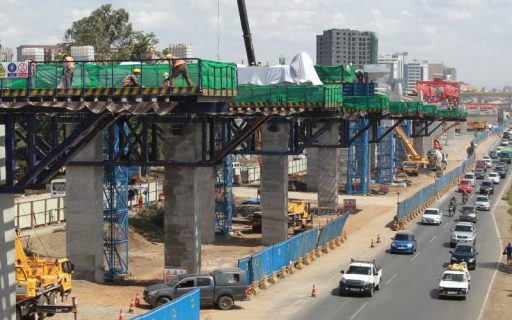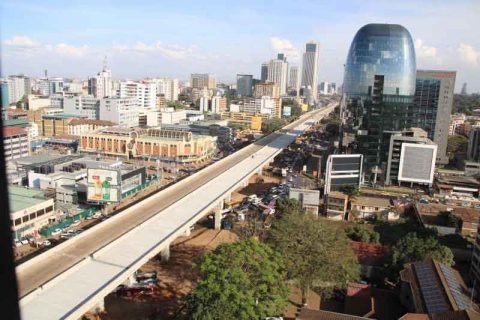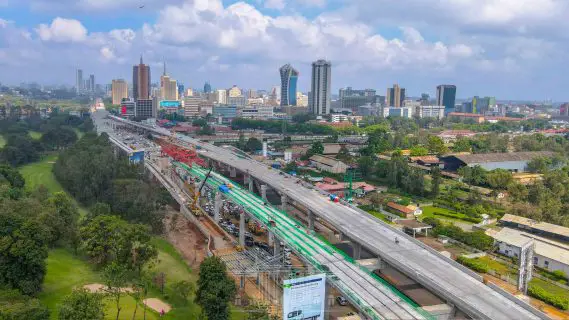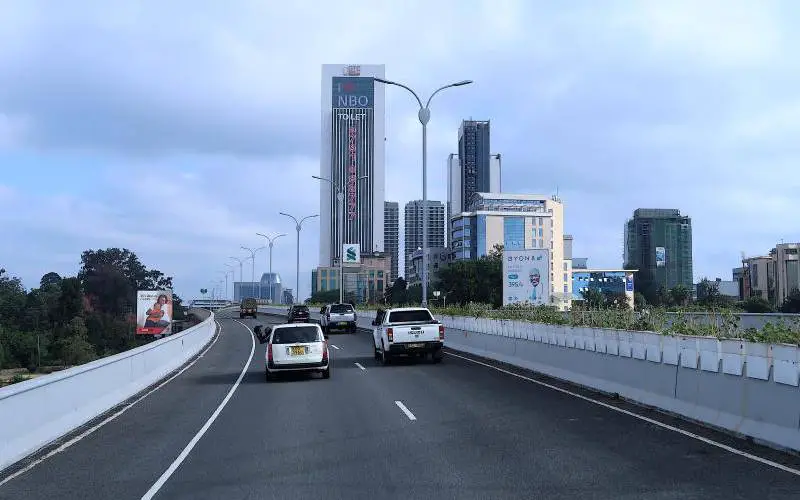The Nairobi Expressway is a 27.1km toll road that begins from Mlolongo through the Jomo Kenyatta International Airport (JKIA) and Nairobi’s CBD to Westland’s area along Waiyaki Way.
The project for the construction of the road was developed by MOJA Expressway Company Limited at a cost of US $560m or its thereabouts. China Roads and Bridges Company (CRBC) was the main contractor. Construction began in June 2020 and was completed in 2022.
The project is the first major project in Kenya to be carried out through a PPP model.
Overview of the Nairobi Expressway
The Nairobi Expressway has a four-lane and six-lane dual carriageway within the existing median of Mombasa Road, Uhuru Highway, and Waiyaki Way as well as 10 interchanges. The section between the Eastern and Southern bypasses is a six-lane dual carriageway while the section from the Eastern Bypass and that from the Southern Bypass to James Gichuru is a four-lane dual carriageway.
The elevated highway is near Ole Sereni Hotel and runs through the CBD along the Uhuru highway up to the James Gichuru junction. Haile Selassie Road, Kenyatta Avenue, and University Way are below the elevated road.
Paying for the Nairobi Expressway
Moja Expressway company which operates the 27-kilometer Nairobi Expressway only accepts cash, electronic, and manual toll collection modes of payment.
To register for the electronic tolling cards (ETC) users will need to present;
- A national identity card (ID)
- Logbook of the vehicle they are registering,
- KES 1,000 for installation service, and
- KES 2,000 or more to load funds onto the card.
For the manual tolling cards (MTC) motorists will need;
- A national identity card (ID)
- KES 300 for the installation service charge, and
- At least KES 1,000 loaded in points.
Noteworthy, the ETC mode of payment allows motorists to pass toll booths more quickly compared to other modes. Moja Expressway plans to roll out a mobile money payment at a later stage.
Two and three-wheeled vehicles are prohibited on the Nairobi Expressway. Only light vehicles with two axles, light vehicles with two axles and a high bonet, heavy vehicles with fewer than four axles and heavy vehicles with four or more axles.
Ambulanxces, police vehicle, military vehicles and fire engines are exempted.
Reported earlier
Oct 2019
Kenya Inaugurates Construction of US $650m JKIA-Westlands Expressway
Kenya has inaugurated the much-awaited construction of the Jomo Kenyatta International Airport JKIA-Westlands Expressway. While presiding over the event, President Uhuru Kenyatta expressed optimism that the contractor will execute and finish the highway as scheduled.
The US $650m expressway
The US $650m project had been slated to kick off in August but was pushed to October and construction is set to begin soon. The 18.586km road project will start at JKIA and end at James Gichuru, along Waiyaki Way, in Westlands. China Road and Bridge Corporation (CRBC) will undertake the mega-project on a public-private partnership (PPP) basis.
The Government clarified that the PPP framework agreement will see CRBC invest its own money and later recoup its investment from toll fees paid by motorists using the road. This is a departure from the past when the government secured loans to fund the construction of major projects.
Motorists will have the option of using the expressway to escape the heavy traffic jams at a fee or toll charges to help the firm recover its investments. However, those using the lower section of the double-decker highway will be spared the toll charges.
Bus rapid transit system
The planned highway will incorporate the bus rapid transit (BRT) system which will involve the construction of a dedicated lane for large-capacity buses to ease congestion. It will be elevated near Ole Sereni Hotel through the City Center along Uhuru Highway up to James Gichuru junction and will be completed within two years. The proposed elevated dual carriageway is to be built in three phases beginning with the first 6.5km running from JKIA to Likoni Road and the Southern Bypass interchange.
The second stretch of 12km will connect Likoni Road to James Gichuru Road junction on Waiyaki Way in Westlands, while the last section will run from James Gichuru Road to Rironi, on the Nairobi-Nakuru highway. The road will come with multiple interchanges at intersections on Popo-Kapiti, Lang’ata-Lusaka, Bunyala, Rhapta, and James Gichuru roads.
What we reported in July 2020
Kenya in search of a consultancy firm for the Nairobi Expressway Project
The national government of the Republic of Kenya through the Ministry of Transport, Infrastructure, Housing, Urban Development, and Public Works represented by the Kenya National Highways Authority (KeNHA), a state corporation established under the Kenya Roads Act and charged with the mandate to manage, develop, rehabilitate and maintain national roads is in search of a consultancy firm for the ongoing Nairobi Expressway Project.
The authority has already published a tender notice that is valid until the 4th of August this year, inviting proposals from qualified and experienced consulting firms with the capacity to independently assist in the management of the implementation of the project agreement between the authority and the contractor, China Road and Bridge Corporation (CRBC).
The selected firm will be given the mandate to review plans by CRBC, inspect, and monitor the progress of construction works and eventually conduct tests on the road before issuing the contractor a certificate of completion.
In July, CRBC announced that it has successfully completed the foundation expansion of two bridges, indicating that the construction of the first section of the project was in full swing.
“The pouring content is the expanded foundation of No.10 pier and No.11 pier of the viaduct of the Project. The size of the lower foundation is all 11.8 * 5.8 * 1m and that of the upper foundation is all 7.8 * 3.8 * 1m, totaling 199.5m2 of concrete. After pouring, the data tested are normal,” read the statement.
The company said that the Project Department has overcome the adverse impact caused by the epidemic situation, made overall arrangements for construction, paid attention to safety protection, quality monitoring, logistics support, and other aspects, and ensured the high quality and efficient completion of this pouring task, accumulating valuable experience for subsequent construction and laying a solid foundation for successful completion of subsequent construction tasks.
September 2020
Traffic disruptions on Waiyaki Way amid Nairobi Expressway construction
Traffic along Waiyaki Way will be disrupted and diverted between September 26 and April 1, 2021, in a bid to facilitate the ongoing construction of the Nairobi Expressway. This is according to a statement released by Peter Mundinia, the Kenya National Highways Authority (KeNHA) director-general.
Mundinia said that Waiyaki Way from Goodman Towers opposite St Marks Anglican Church to Sanlam Towers some 500 meters away will be closed completely while they pull down the St Mark’s footbridge.
“All vehicles from CBD to James Gichuru Road will have to turn left into the service road before the St Mark’s footbridge and rejoin Waiyaki Way after Mvuli Road. Pedestrians are advised to use the designated pedestrian crossing in front of Park Inn Hotel,” explained the KeNHA director-general.
The disruption will also affect some sections of Mombasa Road and Uhuru Highway within the same period.
In December, the erection of the Box Girder for the project was launched ushering a new stage for the project.
CRBC said that since the commencement of construction, the expressway project department has planned ahead of time, organized and made overall arrangements scientifically, focused on epidemic prevention and control and highlighted key routes, steadily pushed forward construction and production, and fulfilled the annual tasks and targets ahead of schedule, laying a solid foundation for the smooth completion of the Project.

2021
What we reported in March 2021
Four footbridges to be relocated to pave way for new Nairobi expressway
In March Kenya National Highways Authority (KeNHA) director-general Peter Mundinia announced that four pedestrian bridges will be demolished and relocated to new sites along the corridor to pave way for the Nairobi Expressway project.
The first two footbridges are situated at Mlolongo and Imara Daima near Libra House along Kenya’s first-double decker highway; while the other two are situated at General Motors on Enterprise Road and at St Mark’s church in Westlands, Nairobi.
What we reported in July 2021
Kenya’s Nairobi Expressway project to be ready in February 2022
In mid-July, Transport and Infrastructure Cabinet Secretary (CS) James Macharia announced that the Nairobi Expressway project is set to be ready by February next year, six months ahead of schedule. According to the CS, the government has pushed the contractor to deliver it early to ease traffic snarl-up on the busy highway.
“We requested the Ministry of Interior to offer security to the contractor to ensure smooth operations on a 24-hour basis. We are glad they are working in shifts that will see the road completed before schedule,” said CS Macharia.
What we reported in August 2021
The completion date for the Nairobi Expressway project in Kenya pushed to June
The completion date for the Nairobi Expressway project in Kenya has been pushed to June 2022 from February as initially planned. The Kenya National Highways Authority (KeNHA) announced that the project is 57% complete with the heavy works having been accomplished.
“Between now and December 2021, we are likely to see all the heavy works involving deep excavation, and diversions completed, and in the period between January 2022 and June 2022, we will proceed to install the infrastructure that will enable us to operate the road furniture, marking, and the toll stations,” said Wangai Ndirangu KeNHA chairman.
November 2021.
The highway was nearing completion.

Earlier in November, Transport Cabinet Secretary James Macharia revealed that the Sh63 billion Nairobi Expressway was at 75per cent completion and only needed another four months to be finalized.
Museum Hill road link to Thika Superhighway was not complete but was opened to ease traffic flow. Due to the ongoing construction on the expressway, a number of roads linked to the project were closed, resulting in massive traffic along the route.
He revealed that construction on the main section of the road and its supporting infrastructure such as toll stations was complete. The mega-infrastructure scheme has also impacted the value of the real estate in the area. Experts are reckoning that the 27-kilometer (km) project will lead to the rezoning of some of the parts it stretches through.
December 2021.
On Thursday 24th, President Uhuru Kenyatta made an extensive inspection tour of the 27.1km Nairobi Expressway which was 93% complete.

He was accompanied by Infrastructure CS James Macharia and NMS DG Mohamed Badi, who expressed his satisfaction with the progress of the 8-lane elevated dual carriageway whose completion is scheduled for March 2022.
March 2022
Nairobi Expressway to come into use on Trial Basis in March 2022
Nairobi Expressway will start being used by motorists in March the Transport Cabinet Secretary in Kenya, James Macharia, has announced. The 27-kilometer expressway that stretches from Mlolongo through Uhuru Highway to the James Gichuru Road junction in Westlands will be used on a trial basis in March 2022, approximately three months earlier than anticipated.
Earlier Kung’u Ndung’u, the director-general of the Kenya National Highways Authority (KeNHA), had revealed that the construction works on the highway were 82 percent complete overall. Construction of the operation and monitoring center stood at 99.5 percent while 98.5 percent of elevated sections had been built.
According to the Transport Cabinet Secretary, the expressway is now 95 percent complete, and most of the machinery that was being used has been moved to construct the Langata road viaducts.
“What is remaining to complete the project is auxiliary infrastructure including the 27- toll booths that are almost done. Once everything is ready on the toll booths we will test the cashless system which will require drivers to have a card that they will load in money and then use to gain access to the expressway,” explained Macharia.
Restoring vegetation along the Nairobi Expressway
CS Macharia said that the contractor as part of the project will be planting new trees and flowers along the expressway in a bid to restore the flora. The exercise has already begun on Mombasa Road where flowers including wall creepers have been planted using a modern agricultural process known as aquaponic vertical farming.
According to the National Environment Management Authority (Nema) of Kenya, the exercise will open green spaces to compensate for the permanent loss of vegetation and destruction of bird habitats at Nyayo Stadium and the Westlands roundabouts.
“The proponent will collaborate with private partners and State agencies to offset the loss of vegetation by planting trees in areas such as Nairobi National Park, Uhuru Park, City Park and Arboretum, public schools, and other lands along the corridor,” said Nema in a statement.
Dec 2022
Five new footbridges are to be constructed on Nairobi Expressway
The construction of five-foot bridges on the Nairobi Expressway, spanning 27 kilometers, is set to relieve many pedestrians. People have been struggling to cross the fortified and congested highway.
The Kenya National Highways Authority declared its commitment to improving users’ safety. The authority claims that it has planned the phased construction of additional footbridges from Mlolongo to the Southern Bypass Interchange and along the Westlands section from the Aga Khan School to the junction with Brookside Drive.
The authority stated that the five-foot bridges are in the scope of work to be carried out.
Why KeNHA is building the five-foot bridges along the expressway
The lack of footbridges has resulted in lots of injuries and deaths among pedestrians using the road in a dangerous manner. One of the key legacy projects completed by former President Uhuru Kenyatta was the expressway. The project’s cost was close to Sh100 billion to construct.
The completion of the expressway was expected to ease traffic on the congested road. It was also expected to speed up traffic to and from the Jomo Kenyatta International Airport (JKIA).
The repair of the Mombasa Road
KeNHA noted that the Nairobi Expressway’s project company and developer, MOJA Expressway Company Limited, through their Engineer, Procure, and Construct Contractor, CALE Infrastructure Construction Company, is slowly repairing parts of the existing Mombasa Road where damage was directly brought on by the Nairobi Expressway’s construction.
Prior to the end of the year, 2022, the MOJA-mandated repair work will be completed. However, relocation work, such as moving water and sewer pipes, power lines, and ICT fiber cables, caused damage to the previously existing road and road reserve at several locations.
The respective government utility companies, which are handled by KeNHA, and also the respective utility companies carried out the activities.
The existing road’s roadside drainage and sidewalks were both affected by these relocation activities. Funds from KeNHA have been provided for repairs. The company is also working with government utility companies to make sure the repairs are carried out effectively.
June 2023
Nairobi Expressway Closed for Construction
The Moja Expressway Company has announced the closure of a section of the Nairobi Expressway for construction work at the JKIA Toll Station Exit.
The closure will affect one lane of the expressway, while the other lane will remain open. Motorists have been advised to exercise caution and follow temporary traffic control measures during the construction period.
The construction started on June 4, 2023, and is expected to be completed by June 13, 2023. The Nairobi Expressway, which opened in May, offers drivers a scenic route and an alternative to the congested Mombasa Road.
However, the expressway has faced challenges, including a recent system failure caused by construction work that damaged fiber cables.
To accommodate growing traffic, plans have been announced to add additional lanes at certain exits and entrances along the expressway.
The Chinese-built Nairobi Expressway handles an average daily traffic volume of 50,000 vehicles.


when is contractors going to erect foot bridge at nation printing premises at Mombasa road. pedestrians are really suffering